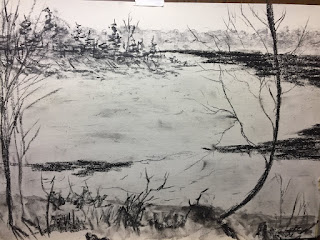Charcoal and Tracing Paper Experiments
I occasionally like to experiment with tracing paper. Not to trace compositions, but I enjoy the feel charcoal on tracing paper. Using tracing paper and even newsprint was also recommended by noted illustrators Robert Fawcett and Charles La Salle for practice. I enjoy finding instructional books by artists such as these for inspiration. Andrew Loomis is another favorite of mine. The effects that Loomis and La Salle were able to achieve in Charcoal were amazing. And Fawcett is an acknowleged master of line. They make it look so easy. Any expert does.
I also like to see what the composition looks like in reverse. While looking at a few of my paintings and drawings in preparation for entering another juried exhibition, I also noticed the difference the colored background makes.
In this case I imagined a stormy sea where visibility was quite limited. This was done from imagination, through I do enjoy storm watching along the coast. The first image is simply with a piece of white paper behind the tracing paper charcoal drawing.
In the second picture, I've simply moved the white paper to the right and left the natural color of the drawing board (brown) to show through. It does demonstrate a different mood.
The image below is with the image reversed. Tracing paper makes this quick and easy - of course this can be done even more simply with basic computer software - but for me I prefer to go "old school"
I continue to be reminded on a regular basis that in art, and in life, there is no substitute for doing the work. Reading about drawing or painting does no more to make you an artist than reading about playing the piano makes one a piano player.







Comments
Post a Comment